
Identify the
amide, and
a.  c.
c.  e.
e. 
Darvon ibuprofen penicillin G
(analgesic) (analgesic) (an antibiotic)
b.  d.
d. 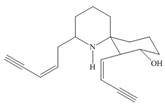 f.
f. 
pregabalin histrionicotoxin pyrethrin I
trade name Lyrica (poison secreted by a (potent insecticide
(used in treating chronic south American frog) from chrysanthemum)
Pain)
(a)
Interpretation: The functional groups present in the given molecule is to be classified and the classification of each alcohol, alkyl halide, amide, and amine as
Concept introduction: The table representing the general formula of different functional groups according to IUPAC convention is given below.
| General formula | Functional group | Functional group name |
| Alcohol | ||
| Aldehyde | ||
| Ketone | ||
| Amine | ||
| Ether | ||
| Ester | ||
| Alkyl halide | ||
| Double bond | ||
| Carboxylic acid |
The classification of alcohols or alkyl halides depend upon the number of carbon atoms attached to the carbon that contains hydroxyl group or alkyl halide. In case of primary alcohol,
The classification of amines or amides also depends upon the number of carbon atoms attached to the carbon that contains nitrogen atom.
Answer to Problem 3.32P
The functional groups present in Darvon are shown below.
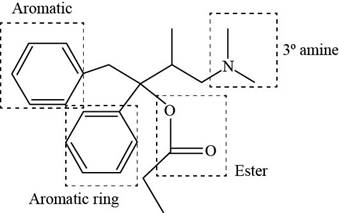
Explanation of Solution
The given compound is,

Figure 1
The functional groups present in Darvon are amine, ester and aryl group.
The structure of Darvon that shows the labeling of all functional groups is shown below.

Figure 2
The functional groups present in Darvon and the classification of each alcohol, amide, alkyl halide and amine as primary, secondary, and tertiary are rightfully stated.
(b)
Interpretation: The functional groups present in the given molecule is to be classified and the classification of each alcohol, alkyl halide, amide, and amine as
Concept introduction: The table representing the general formula of different functional groups according to IUPAC convention is given below.
| General formula | Functional group | Functional group name |
| Alcohol | ||
| Aldehyde | ||
| Ketone | ||
| Amine | ||
| Ether | ||
| Ester | ||
| Alkyl halide | ||
| Double bond | ||
| Carboxylic acid |
The classification of alcohols or alkyl halides depend upon the number of carbon atoms attached to the carbon that contains hydroxyl group or alkyl halide. In case of primary alcohol,
The classification of amines or amides also depends upon the number of carbon atoms attached to the carbon that contains nitrogen atom.
Answer to Problem 3.32P
The functional groups present in pregabalin are shown below.
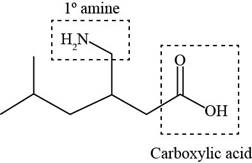
Explanation of Solution
The given structure is,
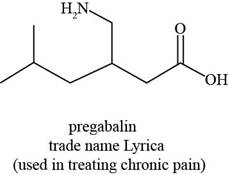
Figure 3
The functional groups present in pregabalin are amine, and carboxylic acid.
The structure of pregabalin that shows the classification of all functional group is shown below.

Figure 4
The functional groups present in pregabalin and the classification of each alcohol, amide, alkyl halide and amine as primary, secondary, and tertiary are rightfully stated.
(c)
Interpretation: The functional groups present in the given molecule is to be classified and the classification of each alcohol, alkyl halide, amide, and amine as
Concept introduction: The table representing the general formula of different functional groups according to IUPAC convention is given below.
| General formula | Functional group | Functional group name |
| Alcohol | ||
| Aldehyde | ||
| Ketone | ||
| Amine | ||
| Ether | ||
| Ester | ||
| Alkyl halide | ||
| Double bond | ||
| Carboxylic acid |
The classification of alcohols or alkyl halides depend upon the number of carbon atoms attached to the carbon that contains hydroxyl group or alkyl halide. In case of primary alcohol,
The classification of amines or amides also depends upon the number of carbon atoms attached to the carbon that contains nitrogen atom.
Answer to Problem 3.32P
The functional groups present in ibuprofen are shown below.
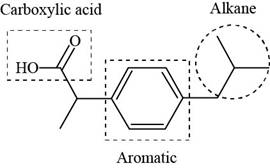
Explanation of Solution
The given structure is,

Figure 5
The functional groups present in ibuprofen are carboxylic acid, alkane and aryl.
The structure of ibuprofen that shows the classification of all functional group is shown below.

Figure 6
The functional groups present in ibuprofen and the classification of each alcohol, amide, alkyl halide and amine as primary, secondary, and tertiary are rightfully stated.
(d)
Interpretation: The functional groups present in the given molecule is to be classified and the classification of each alcohol, alkyl halide, amide, and amine as
Concept introduction: The table representing the general formula of different functional groups according to IUPAC convention is given below.
| General formula | Functional group | Functional group name |
| Alcohol | ||
| Aldehyde | ||
| Ketone | ||
| Amine | ||
| Ether | ||
| Ester | ||
| Alkyl halide | ||
| Double bond | ||
| Carboxylic acid |
The classification of alcohols or alkyl halides depend upon the number of carbon atoms attached to the carbon that contains hydroxyl group or alkyl halide. In case of primary alcohol,
The classification of amines or amides also depends upon the number of carbon atoms attached to the carbon that contains nitrogen atom.
Answer to Problem 3.32P
The functional groups present in histrionicotoxin are shown below.

Explanation of Solution
The given structure is,

Figure 7
The functional groups present in histrionicotoxin are alkene, alkyne and alcohol. The structure of histrionicotoxin that shows the labeling of all functional group is shown below.

Figure 8
The functional groups present in histrionicotoxin and the classification of each alcohol, amide, alkyl halide and amine as primary, secondary, and tertiary are rightfully stated.
(e)
Interpretation: The functional groups present in the given molecule is to be classified and the classification of each alcohol, alkyl halide, amide, and amine as
Concept introduction: The table representing the general formula of different functional groups according to IUPAC convention is given below.
| General formula | Functional group | Functional group name |
| Alcohol | ||
| Aldehyde | ||
| Ketone | ||
| Amine | ||
| Ether | ||
| Ester | ||
| Alkyl halide | ||
| Double bond | ||
| Carboxylic acid |
The classification of alcohols or alkyl halides depend upon the number of carbon atoms attached to the carbon that contains hydroxyl group or alkyl halide. In case of primary alcohol,
The classification of amines or amides also depends upon the number of carbon atoms attached to the carbon that contains nitrogen atom.
Answer to Problem 3.32P
The functional groups present in penicillin G are shown below.
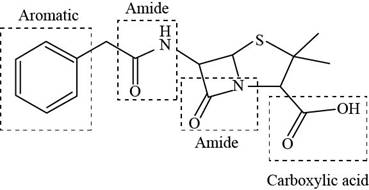
Explanation of Solution
The given structure is,

Figure 9
The functional groups present in penicillin G are carboxylic acid, amide, and aryl.
The structure of penicillin G that shows the labeling of all functional group is shown below.

Figure 10
The functional groups present in penicillin G and the classification of each alcohol, amide, alkyl halide and amine as primary, secondary, and tertiary are rightfully stated.
(f)
Interpretation: The functional groups present in the given molecule is to be classified and the classification of each alcohol, alkyl halide, amide, and amine as
Concept introduction: The table representing the general formula of different functional groups according to IUPAC convention is given below.
| General formula | Functional group | Functional group name |
| Alcohol | ||
| Aldehyde | ||
| Ketone | ||
| Amine | ||
| Ether | ||
| Ester | ||
| Alkyl halide | ||
| Double bond | ||
| Carboxylic acid |
The classification of alcohols or alkyl halides depend upon the number of carbon atoms attached to the carbon that contains hydroxyl group or alkyl halide. In case of primary alcohol,
The classification of amines or amides also depends upon the number of carbon atoms attached to the carbon that contains nitrogen atom.
Answer to Problem 3.32P
The functional groups present in pyrethrin I are shown below.
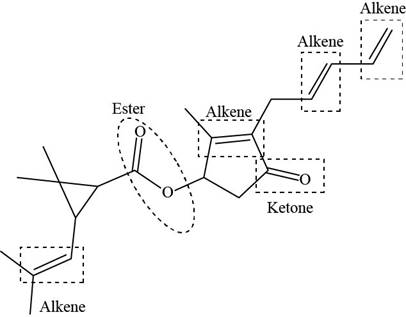
Explanation of Solution
The given structure is,

Figure 11
The functional groups present in pyrethrin I are ester, ketone, and alkene.
The structure of pyrethrin I that shows the labeling of all functional group is shown below.

Figure 12
The functional groups present in pyrethrin I and the classification of each alcohol, amide, alkyl halide and amine as primary, secondary, and tertiary are rightfully stated.
Want to see more full solutions like this?
Chapter 3 Solutions
ORGANIC CHEMISTRY
- acetylsalicylic acid vs salicylic acid? What is the main chemical difference? Why can acetylsalicylic acid pass through the stomach without harm while salicylic acid can cause harm to the stomach????arrow_forwardV. Classify each amine as 1', 2 or 3'. Give the IUPAC name for each amine. CH3 a. CH3CHCH,CH2NHCH3 b. CH3-C-CH,NH2 ČH3 ČH3arrow_forwardAmide hydrolysis in basic conditions forms A. a carboxylic acid and an amine B. a carboxylate salt and an amine 3. an ester and an amine 4. a carboxylic acid and an amine saltarrow_forward
- Jj.166. Draw each amide. N-butyl-N-methylbenzamidearrow_forwardWhat are the functional groups present in this antibacterial antibiotic? A. Nitro, phenyl, amine, carbonyl, hydroxyl B. Nitro, phenyl, amine, carbonyl, C. Nitro, phenyl, amine, hydroxyl D. Nitro, phenol, amine, carbonyl, hydroxyl A brief explanation would be highly appreciated + upvotearrow_forwardReduction of an alkyl azide results in the formation of —-. A. an imine B. an oxime C. a tertiary amine D. a secondary amine E. a primary aminearrow_forward
- does methanol and methanol amine overlap each other are Scheme 1 Model A. Methanol: Model B. Methanol amine + red ball- no need of the H yellow red ball H- yellow ball blue ball NH2arrow_forwardexplain the solubility behavior of each representatives amine in water a. aniline b. diethylamine c. N,N-diethylanilinearrow_forwardName each amine. CH;-CH,-N-CH,-CH, b. CH3-CH,-CH2-N-CH3 H CH3 CH3-CH2-CH2-N-CH2-CH;-CH2-CH3arrow_forward
- 3. Give the pharmacological property of the following alkaloids. Where do they naturally occur? a. morphine b. quinine c. berberine 4. What are the chemical tests used in identifying alkaloids?arrow_forwardName each amine. b. CH;-CH2-CH2-N-CH, H CH3 c. CH3-CH2-CH;-N-CH,-CH;-CH2-CH;arrow_forwardThe structures of four amines are shown. NH NH2 NH CH, -CH, H,C-E- -CH HyC- CH CH, CH3 В. "CH CH, CH A. C. D. Which of the structures are constitutional isomers of A? OC B.arrow_forward
 ChemistryChemistryISBN:9781305957404Author:Steven S. Zumdahl, Susan A. Zumdahl, Donald J. DeCostePublisher:Cengage Learning
ChemistryChemistryISBN:9781305957404Author:Steven S. Zumdahl, Susan A. Zumdahl, Donald J. DeCostePublisher:Cengage Learning ChemistryChemistryISBN:9781259911156Author:Raymond Chang Dr., Jason Overby ProfessorPublisher:McGraw-Hill Education
ChemistryChemistryISBN:9781259911156Author:Raymond Chang Dr., Jason Overby ProfessorPublisher:McGraw-Hill Education Principles of Instrumental AnalysisChemistryISBN:9781305577213Author:Douglas A. Skoog, F. James Holler, Stanley R. CrouchPublisher:Cengage Learning
Principles of Instrumental AnalysisChemistryISBN:9781305577213Author:Douglas A. Skoog, F. James Holler, Stanley R. CrouchPublisher:Cengage Learning Organic ChemistryChemistryISBN:9780078021558Author:Janice Gorzynski Smith Dr.Publisher:McGraw-Hill Education
Organic ChemistryChemistryISBN:9780078021558Author:Janice Gorzynski Smith Dr.Publisher:McGraw-Hill Education Chemistry: Principles and ReactionsChemistryISBN:9781305079373Author:William L. Masterton, Cecile N. HurleyPublisher:Cengage Learning
Chemistry: Principles and ReactionsChemistryISBN:9781305079373Author:William L. Masterton, Cecile N. HurleyPublisher:Cengage Learning Elementary Principles of Chemical Processes, Bind...ChemistryISBN:9781118431221Author:Richard M. Felder, Ronald W. Rousseau, Lisa G. BullardPublisher:WILEY
Elementary Principles of Chemical Processes, Bind...ChemistryISBN:9781118431221Author:Richard M. Felder, Ronald W. Rousseau, Lisa G. BullardPublisher:WILEY





